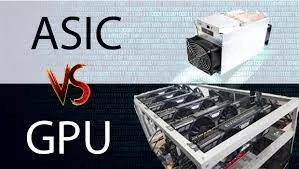
In the mining of different cryptocurrencies, dedicated GPUs for gaming are currently out of stock, due to miners who hoard almost all the stock, even before it reaches the stores. But to solve this problem there are specific devices for mining cryptocurrencies called ASICs.
To mine Bitcoin, Litecoin, Ethereum, DASH, or any other cryptocurrency, the most effective way to do it is with dedicated hardware known as ASIC miner or ASIC miner.
ASIC stands for Application Specific Integrated Circuit, in this case for cryptocurrency mining, so it is hardware that has been designed specifically for a particular purpose.

In a nutshell, mining runs complicated calculations in the search for a specific number, and whether it is done with a conventional GPU or with an ASIC miner, the mining hardware must run many, many calculations in order to hit the desired number. In proof-of-work systems such as Bitcoin, the first one to find the number gets the full reward, although there are other types of mining (pools) that when someone in the group finds the number, the reward is divided among all depending on their contribution to the calculations and, therefore, the mining power you are providing equals the net benefit in the form of cryptocurrencies.
It is for this reason that many miners opt directly for investing in an ASIC, as it gives them a greater chance of being the ones to find the number that will give them the cryptocurrency, or in the case of participating in pools, they will have a greater share of participation and thus a higher profit.
Each cryptocurrency has its own cryptographic hash algorithm, and ASIC miners are designed to mine using that particular algorithm. ASICs that mine Bitcoin is designed to calculate the SHA-256 hash algorithm, while those that mine Litecoin, use Scrypt. Technically you can mine any other coin that is based on the same algorithm, although generally as each ASIC is designed for a particular coin, it is ideal to mine only that one.

ASIC vs. GPU
ASICs are better than GPUs for mining; since for mining cryptocurrencies what really matters is that the one you have chosen to mine is worth more than what you spend on electricity and the hardware you have bought for it, i.e. less than the running costs.
If we choose optimized and dedicated hardware for mining, we will have a much more efficient system that will generate much more hashrate per watt consumed than using a normal GPU for mining. A PC with a conventional CPU and GPU is designed to perform a lot of different tasks, but an ASIC is designed only for mining, hence all its computing power is focused on mining exclusively, so they are incredibly powerful and efficient when it comes to mining, offering high hashrate and using much less power than a PC when mining, at least if we were to match them in terms of hashrate (i.e. if an ASIC obtains for example 100 MH/s consuming 100 watts, to reach 100 MH/s with a normal PC you would have to consume about 400 watts of power).
Bitcoin mining, which is the oldest and longest-lived, is currently only done using ASIC miners because the difficulty is so high that it is no longer profitable to do it using conventional PC graphics cards.
One of the disadvantages of ASICs is the initial investment that has to be made since as task-specific devices they are quite specific and very expensive.
One of the most efficient and widely used ASICs for mining is Bitmain's Antminer, which is now in its S19j model. Bitmain's Antminer is capable of a throughput of 90 TH/s (terahashes, not megahashes, which is the usual magnitude).
Bitmain's Antminer has a power consumption of 3,250 watts under normal workload (which is 100%, obviously), and is priced at about $5,000.
